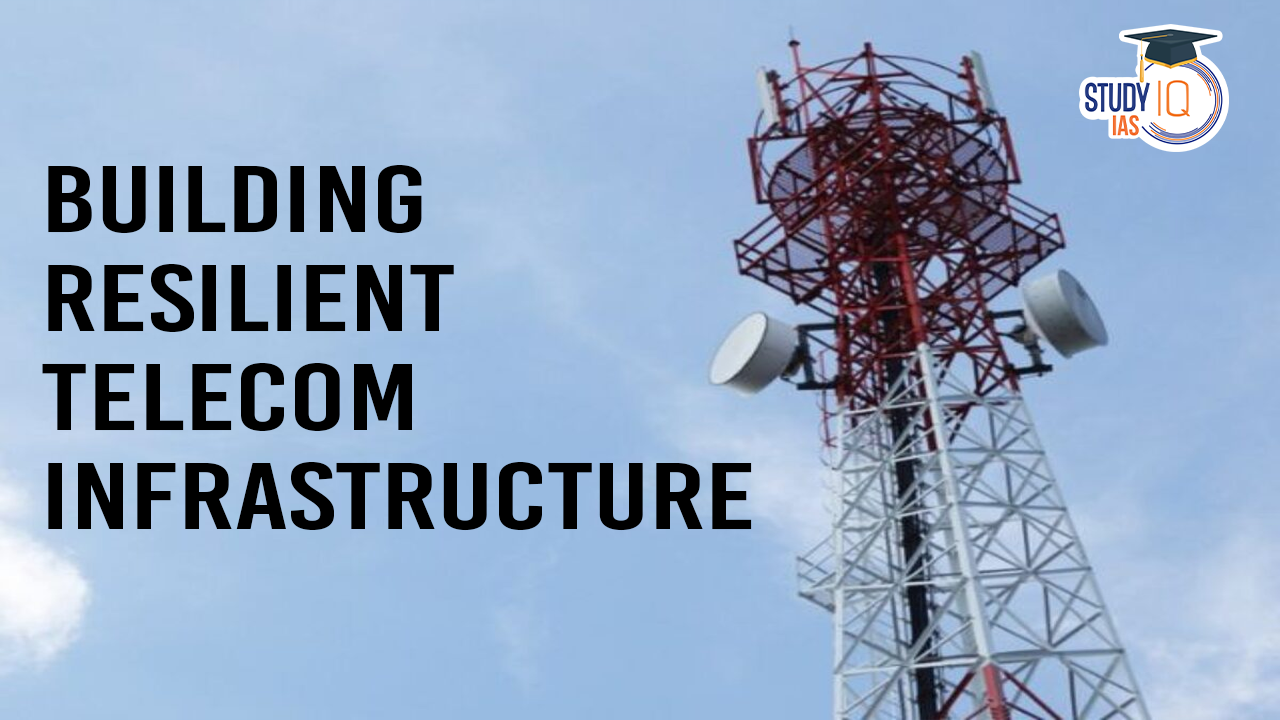Table of Contents
Context: The Coalition for Disaster Resilient Infrastructure has recently released a report assessing Indian telecom networks’ preparedness in the event of disasters. The report provides recommendations for State governments to enhance disaster resilience in telecom infrastructure.
Importance of Telecom Networks in Disaster Management
- Telecom networks are crucial for disaster response as they enable quick communication between:
- State & National Disaster Management Authorities.
- Local municipalities & State/Union governments.
- Disruptions in telecom networks can hinder relief efforts, putting lives and property at risk.
| Coalition for Disaster Resilient Infrastructure (CDRI) |
|
Key Challenges in Disaster-Prone Areas
High Risk in Coastal and Seismic Zones
- Coastal regions face heightened vulnerability as they host undersea cable landing stations, connecting India to the global internet. Disruptions in these cables can lead to massive network failures.
- Cyclones and earthquakes pose a significant risk, potentially damaging telecom towers and cabling infrastructure and leading to prolonged service outages.
Power Failures: The Biggest Issue
- Telecom towers heavily rely on uninterrupted power supply, but disasters often cause long blackouts, delaying network restoration.
- According to the CDRI report power failures are the primary cause of telecom outages, more than physical damage to towers or cables.
- Restoring power to telecom towers during disasters is crucial to maintaining communication networks for emergency response.
Structural Weakness of Telecom Towers
- Many towers are not built to withstand high wind speeds, especially in cyclone-prone states like Odisha, West Bengal, and Andhra Pradesh.
- Poorly designed overhead telecom cables often snap during storms, leading to complete service breakdowns.
- In flood-prone regions, diesel generators stop working when water levels rise, further complicating power restoration efforts.
Solutions for Building a Disaster-Resilient Telecom Network
Strengthening Power Infrastructure
- Ensuring uninterrupted power supply to critical telecom sites.
- Emergency fuel reserves should be maintained to power telecom towers in disaster-hit regions.
- Eg. Odisha provides 50 litres of fuel per telecom operator during cyclones to keep networks operational.
- Alternative power sources like solar or hybrid energy solutions should be implemented to reduce dependency on the electricity grid.
Building Stronger Telecom Towers
- Towers in cyclone-prone areas should meet higher wind resistance standards to prevent collapse.
- Mandatory disaster-proofing for new telecom infrastructure should be enforced to withstand extreme weather conditions.
Shifting to Underground Fiber Optic Cables & Implementing a “Dig-Once” Policy
- Overhead telecom cables are highly vulnerable to storms and cyclones; shifting to underground fibre optic cables can significantly reduce disruptions.
- Dig-once policy should be implemented, ensuring that underground fibre cables are laid alongside water, gas and drainage infrastructure.
- This minimizes repeated disruptions and lowers long-term maintenance costs.
Enhancing Disaster Monitoring & Emergency Response
- Real-time tracking of telecom asset damage using AI-driven software and data analytics for quick restoration.
Financial Resilience Through Parametric Insurance
- CDRI has recommended parametric insurance to financially support telecom operators during disasters.
- This ensures quick compensation, allowing operators to rapidly restore damaged infrastructure.
Future Roadmap for Telecom Resilience in India
Short-Term Initiatives (1-2 Years)
- Strengthening backup power systems at telecom towers with solar/hybrid solutions.
- Implementing real-time damage monitoring tools for quick response.
- Upgrading telecom infrastructure in high-risk coastal and seismic areas.
Medium-Term Initiatives (3-5 Years)
- Expanding underground fibre optic networks nationwide.
- Mandatory disaster-proofing of all new telecom towers in vulnerable regions.
- Establishing a coordinated response mechanism to minimize service downtime during disasters.
Long-Term Vision (Beyond 5 Years)
- Achieving a 100% disaster-resilient telecom infrastructure across India.
- Developing national and state-level telecom disaster preparedness frameworks.
- Encouraging public-private partnerships (PPP) for investment in climate-resilient infrastructure.


 Regional Rural Banks in India, Objective...
Regional Rural Banks in India, Objective...
 Micro, Small and Medium Enterprises (MSM...
Micro, Small and Medium Enterprises (MSM...
 Universal Basic Income (UBI), Need, Adva...
Universal Basic Income (UBI), Need, Adva...





















